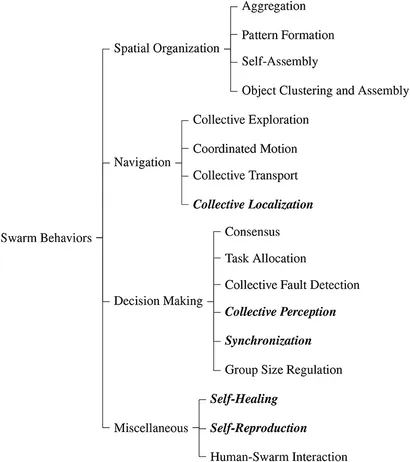Swarm robotics is revolutionizing how we think about robotics and automation. By drawing inspiration from nature, researchers are developing innovative solutions that could transform industries such as agriculture, environmental monitoring, and even space exploration. In this blog, we’ll explore the fascinating world of swarm robotics, its current state, and what the future holds.
What is Swarm Robotics?
Swarm robotics is a field that involves designing, constructing, and deploying large groups of robots that work together to solve problems or perform tasks. It takes inspiration from natural systems such as social insects, fish schools, and bird flocks, which exhibit collective behavior through simple local interactions. The primary goal of swarm robotics is to create multi-robot systems that are robust, fault-tolerant, and flexible, enabling them to adapt to changes in their environment.
A well-known example of swarm robots in the field of swarm robotics is the Kilobots. Developed by the Self-Organizing Systems Research Group at Harvard University, Kilobots are small, affordable robots with basic sensors and actuators. These tiny, cylindrical robots, just a few centimeters in diameter, can work together in large groups of hundreds or thousands.
What makes Kilobots special is their ability to communicate and coordinate with each other, even though each one has limited capabilities. They use infrared signals to share information and make group decisions. This allows them to perform complex tasks through collective behavior, where the group’s combined actions achieve the desired result.
Kilobots are popular in swarm robotics research because they are scalable, simple, and cost-effective. Researchers use them to study different swarm behaviors, like grouping together, forming patterns, transporting objects collectively, and making decisions as a group. The Kilobot platform gives researchers a practical way to explore and test swarm robotics ideas.Kilobots are widely used in research labs around the world and have become a symbol of swarm robotics.
Recommended Reading: Montessori at Home: Simple Tips for Every Parent
The science behind Swarm Robotics
Swarm robotics is based on the idea of swarm intelligence, which is inspired by how social insects behave.
Swarm intelligence algorithms don’t need a central controller. Instead, the robots in a swarm communicate with each other and coordinate their actions on their own.
The article “Swarm Robotic Behaviors and Current Applications” divides swarm behavior into four sub-topics:
- Spatial organization
- Navigation
- Decision making
- Miscellaneous

Swarm robotics involves robots working together in smart ways, inspired by how animals like bees or ants cooperate.
Spatial Organization: Swarm robots use different behaviors to work well together.
- Aggregation: Robots come together in one area, helping them to work closely and help each other.
- Pattern Formation: Robots arrange themselves in specific shapes, like lines or chains, to communicate and move efficiently.
- Self-Assembly: Robots link up to form structures, like building blocks, either physically or through signals.
- Object Clustering and Assembly: Robots team up to move and organize objects, like building materials, for tasks.
Navigation: Swarm robots move around together in organized ways.
- Collective Exploration: Robots work together to explore their surroundings, find objects, or monitor the environment.
- Coordinated Motion: Robots move together in formations, like a line or a flock, to travel efficiently.
- Collective Transport: Robots team up to move large or heavy objects that are too big for one robot alone.
- Collective Localization: Robots figure out where they are in relation to each other, which helps them work together smoothly.
Decision Making: Swarm robots make decisions as a group to work effectively.
- Consensus: Robots agree on one decision from many options, so they act together as a team.
- Task Allocation: Robots assign tasks based on each robot’s abilities to maximize their overall performance.
- Collective Fault Detection: Robots spot and fix problems, like robot malfunctions, to keep everything running smoothly.
- Collective Perception: Robots share information to make smart decisions, like identifying objects or solving problems together.
- Synchronization: Robots coordinate their actions by keeping track of time together, which helps them work in sync.
Miscellaneous: Other important behaviors that make swarm robotics work well.
- Self-Healing: Robots recover from problems on their own, making the swarm more reliable and strong.
- Self-Reproduction: Robots create new robots or copy themselves, making the swarm more independent.
- Human-Swarm Interaction: Humans control or get information from the robots, helping them work together better in various environments.
These behaviors in swarm robotics create efficient and adaptable systems, inspired by how insects work together in nature.
Key applications of swarm robotics
- Search and Rescue: Swarm robots can search for survivors in disaster zones. For instance, after the Nepal earthquake in 2015, a swarm of robots covered a larger area than traditional search teams and accessed hard-to-reach places.
- Environmental Monitoring: Swarm robots can monitor air quality or water pollution. In Beijing, for example, a swarm of robots in 2016 collected real-time data on pollution levels and pinpointed highly polluted areas.
- Agriculture: Swarm robots can plant and harvest crops, and manage pests efficiently. In China, robots planted rice in 2017 faster and more effectively than humans.
- Construction: Swarm robots can construct bridges and buildings swiftly. In Japan, robots built a small bridge in 2018 much quicker than humans could.
- Defense: Swarm robots can patrol borders and detect landmines. Along the US-Mexico border in 2019, robots detected and tracked illegal border crossings.
Challenges and opportunities in swarm robotics
Swarm robotics faces both challenges and opportunities that shape its future. Overcoming these challenges and seizing the opportunities could significantly advance the field. Challenges include:
- Effective Communication and Coordination: Swarm robots need reliable ways to communicate and coordinate for seamless teamwork. Developing algorithms for sharing information and coordinating actions among robots is crucial.
- Robust Robot Design: Swarm robots must withstand various environments, including harsh conditions. Ensuring durability, reliability, and adaptability of individual robots is essential for the overall effectiveness of swarm systems.
- Managing the Swarm Effect: Properly coordinating the swarm to avoid chaos or unpredictable behavior is critical. Control strategies and algorithms are needed to maintain organized behavior, even in complex situations.
Despite these challenges, swarm robotics offers many opportunities:
- Low-Cost Mass Production: Swarm robots can be designed for affordability and easy manufacturing, enabling mass production. This could broaden their use in different industries and applications.
- Tackling Difficult Tasks: Swarm robots can handle tasks that are too risky or complex for traditional robots. Their collective intelligence allows them to solve challenging problems and explore new possibilities.
- Advanced Collective Intelligence: Swarm systems can exhibit emergent behaviors and collective intelligence beyond individual robots’ capabilities. They can learn, adapt, and organize themselves, optimizing performance in dynamic environments.
These opportunities pave the way for advancements in industries such as logistics, agriculture, surveillance, and disaster response. Swarm robotics has the potential to revolutionize how robots operate in the world, creating intelligent systems that efficiently tackle real-world challenges.
Similar Read: Expert Tips to Handle A Call from Your Child’s School
Swarm robotics vs. traditional robotics
swarm robotics, a new and promising field, has the potential to revolutionize industries. Unlike traditional robotics, which is already established, swarm robotics offers unique advantages that make it ideal for certain tasks. Traditional robots are often expensive, complex, and less effective at working together.
One major benefit of swarm robotics is its scalability. This means it can easily handle many robots without making the system overly complicated.
Another advantage is robustness. In swarm robotics, robustness means the system can keep working even if some robots fail. If one robot stops working, the others can still cooperate to finish the job. This is especially useful in dangerous or unpredictable environments where robots might break down.
Swarm robotics also offers adaptability. These robots are simple and affordable, so they can be quickly reprogrammed for different jobs. This flexibility allows swarm robotics to handle various tasks and quickly adjust to different situations, whether it’s changing job requirements or facing new challenges.
In conclusion, swarm robotics is a promising field that’s changing how robots work together. Inspired by nature, like how ants cooperate, it’s bringing new solutions to farming, monitoring the environment, and exploring space. Swarm robots can handle many tasks, keep going even if some break down, and quickly switch roles as needed. As researchers keep improving them, we can expect more ways these robots will make our lives easier and safer
Moonpreneur is on a mission to disrupt traditional education and future-proof the next generation with holistic learning solutions. Its Innovator Program is building tomorrow’s workforce by training students in AI/ML, Robotics, Coding, IoT, and Apps, enabling entrepreneurship through experiential learning.























